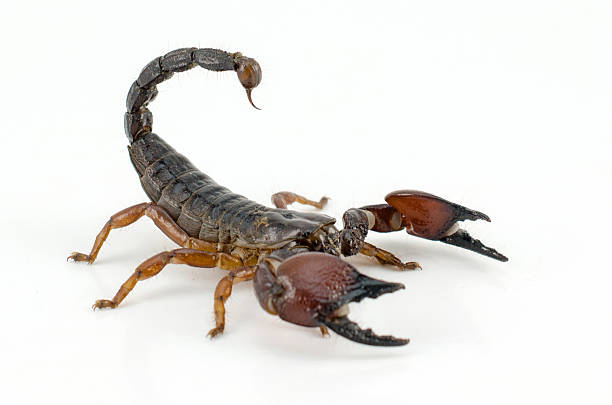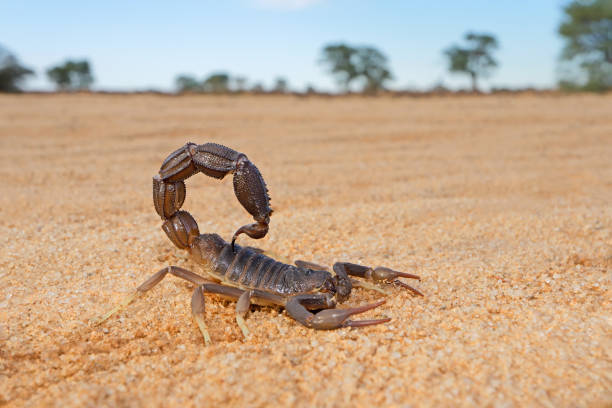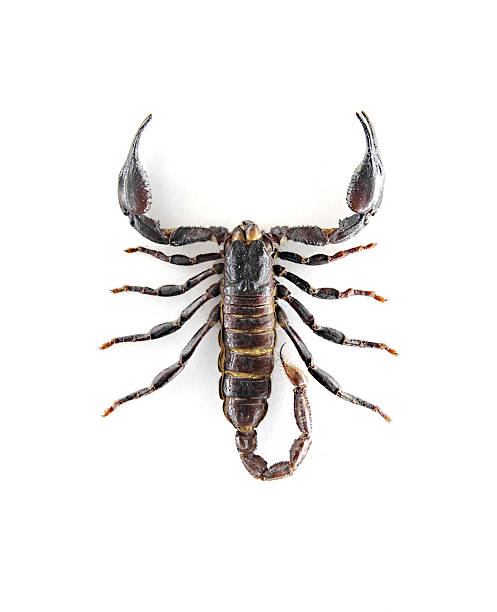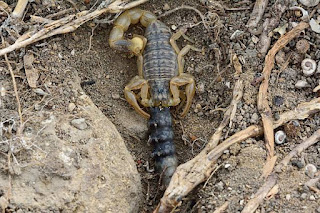 |
| Scorpion |
A scorpion is an arachnid belonging to the class Arachnida and the order Scorpiones. Scorpions are known for their distinctive appearance, with a pair of pincers (called pedipalps) at the front of their body and a segmented tail that curves over their back and ends in a venomous stinger. They have four pairs of legs and typically range in size from a few centimeters to several inches long.
Scorpions are found in various habitats worldwide, including deserts, forests, and grasslands. They are most commonly associated with warm, arid regions, and some species are adapted to survive extreme temperatures and lack of water. Scorpions are nocturnal creatures, hiding during the day and becoming active at night.
One of the defining features of scorpions is their venomous sting. While not all scorpion species are dangerous to humans, some possess venom that can cause painful or even potentially lethal reactions. The severity of the venom varies among species, and medical attention should be sought if someone is stung by a scorpion.
Scorpions are primarily carnivorous, preying on insects, spiders, and other small arthropods. They use their pincers to capture and crush their prey before injecting venom through their stinger. Scorpions also play a role in the ecosystem as both predator and prey.
Scorpion Classification
Scorpions belong to the following classification:
- Kingdom: Animalia
- Phylum: Arthropoda
- Subphylum: Chelicerata
- Class: Arachnida
- Order: Scorpiones
The order Scorpiones includes all scorpion species. Within this order, there are multiple families, genera, and species of scorpions. Some common families of scorpions include Buthidae, Scorpionidae, and Hemiscorpiidae. Each family consists of several genera, and each genus contains multiple species.
It's worth noting that the classification of scorpions may change as new research and discoveries are made. Scientists continually study and revise the taxonomy of organisms to reflect our growing understanding of their evolutionary relationships.
Scorpion Species
Scorpions comprise a diverse group of arachnids, with thousands of species known to date. While it is not possible to provide an exhaustive list of all scorpion species, I can give you an overview of some notable ones:
- Androctonus australis: Commonly known as the North African fat-tailed scorpion, it is one of the most venomous scorpion species. It is found in North Africa and parts of the Middle East.
- Centruroides sculpturatus: Also known as the Arizona bark scorpion, this species is found in the southwestern United States and northern Mexico. It is venomous and known for its painful sting.
- Hottentotta tamulus: This scorpion species, commonly referred to as the Indian red scorpion, is found in India and parts of Southeast Asia. It is highly venomous and poses a significant medical threat.
- Leiurus quinquestriatus: Known as the deathstalker scorpion, it is found in North Africa and the Middle East. This species is highly venomous and its sting can be dangerous, particularly for children or individuals with pre-existing health conditions.
- Tityus serrulatus: Found in Brazil, this scorpion species is commonly called the Brazilian yellow scorpion. It is one of the most venomous scorpions in South America and poses a risk to human health.
- Pandinus imperator: Known as the emperor scorpion, it is one of the largest scorpion species. Native to West Africa, it is often kept as a pet due to its relatively mild venom and fascinating appearance.
- Scorpio maurus: Also known as the black fat-tailed scorpion, it is found in North Africa and the Middle East. It is venomous, and its sting can cause severe pain and health complications.
Each species has its own specific habitat preferences, adaptations, venom potency, and behavior patterns. It's important to remember that while scorpions can be fascinating creatures, some species can pose risks to humans due to their venomous stings. Caution should always be exercised when encountering scorpions in the wild or when handling them.
Scorpion Appearance
Scorpions have a distinctive appearance that sets them apart from other arachnids. Here is a detailed explanation of their physical features:
- Body Structure: Scorpions have two main body regions—the cephalothorax (prosoma) and the abdomen (opisthosoma). The cephalothorax contains the head, eyes, mouthparts, and four pairs of legs. The abdomen is elongated and divided into distinct segments, ending with the tail (metasoma).
- Pincers (Pedipalps): At the front of the cephalothorax, scorpions have a pair of large, grasping pincers called pedipalps. These modified appendages are used for capturing and immobilizing prey, defense, and sensory functions. The pedipalps are often strong and have jagged edges for gripping prey tightly.
- Tail and Stinger: The elongated abdomen of a scorpion curves over its back and ends with a bulbous segment called the metasoma. At the tip of the metasoma, scorpions have a venomous stinger (telson). The stinger is equipped with a venom gland that produces venom, which can be injected into prey or used for defense.
- External Skeleton (Exoskeleton): Like all arthropods, scorpions have an external skeleton made of a tough, flexible material called chitin. This exoskeleton provides protection and support for the scorpion's body. The exoskeleton is segmented, allowing for flexibility and movement.
- Eyes: Scorpions typically have a varying number of eyes, depending on the species. Most scorpion species have a combination of median eyes (located centrally on the head) and lateral eyes (located on the sides). However, their eyesight is generally not very strong, and they rely more on other sensory organs.
- Coloration and Camouflage: Scorpions come in a range of colors, including yellow, brown, black, and even fluorescent green or blue. The coloration often helps them blend into their natural habitat, providing camouflage and protection from predators.
- Size: Scorpions exhibit significant variation in size. The smallest species may be just a few centimeters long, while the largest scorpions can exceed 20 centimeters (8 inches) in length.
It's important to note that scorpion appearance can vary among species, and the specific characteristics mentioned above may differ to some extent. These features, however, collectively contribute to the recognizable and fascinating appearance of scorpions.
Scorpion Habitat
Scorpions are found in various habitats around the world, but they are most commonly associated with arid and semi-arid regions. Here is a detailed explanation of scorpion habitats:
- Deserts: Many scorpion species are well adapted to desert environments and are commonly found in sandy or rocky deserts. They have evolved mechanisms to survive extreme temperatures, low humidity, and scarcity of water. Examples of desert-dwelling scorpion species include the Arizona bark scorpion in the Sonoran Desert and the Sahara Desert scorpion in North Africa.
- Grasslands and Savannas: Scorpions can also be found in grasslands and savannas, especially in areas with rocky outcrops or burrow-friendly soil. They may inhabit the gaps between rocks, under vegetation, or in burrows dug by themselves or other animals. Some grassland scorpion species include the African grassland scorpion and the yellow ground scorpion found in parts of North America.
- Forests: While scorpions are more commonly associated with arid environments, certain species are adapted to forested habitats. These forest-dwelling scorpions often inhabit the leaf litter, under tree bark, or in rotting logs. The European black scorpion and the Guiana scorpion are examples of scorpion species found in forested areas.
- Mountains: Scorpions can be found in mountainous regions as well, including high-altitude environments. They may inhabit crevices, rocky slopes, or caves in mountainous areas. The Himalayan scorpion is one example of a scorpion species adapted to high-altitude mountain habitats.
- Subterranean: Some scorpion species are adapted to living underground or in subterranean environments. These scorpions may construct complex burrow systems and spend the majority of their lives in the dark, hidden from sight. They can be found in various habitats, including deserts, grasslands, and forests.
It's important to note that scorpion habitats can vary depending on the specific species and their geographic distribution. Scorpions are diverse and can adapt to a range of environments, but they generally prefer areas that provide shelter, moisture, and access to prey.
Scorpion Diet and Nutrition
Scorpions are carnivorous arachnids that primarily feed on a diet consisting of insects, spiders, and other small arthropods. Here is a detailed explanation of their diet and nutrition:
- Prey Selection: Scorpions are opportunistic predators and will consume a wide variety of invertebrates. Their diet typically includes beetles, ants, termites, grasshoppers, crickets, spiders, and even other scorpions. The specific prey choice may vary depending on the scorpion species, its habitat, and availability of food sources.
- Hunting Techniques: Scorpions employ different hunting strategies to capture their prey. They may use their pincers to grasp and immobilize the prey, and their venomous stinger to inject venom, paralyzing or killing it. Scorpions possess sensory hairs on their pincers and other body parts, enabling them to detect vibrations and movements of potential prey.
- Feeding Behavior: Once a scorpion captures its prey, it uses its pedipalps and mouthparts to tear and crush the prey's exoskeleton or soft tissues. Scorpions are equipped with digestive enzymes that break down the prey's body tissues, allowing them to extract the necessary nutrients.
- Nutrition: The diet of scorpions provides them with essential nutrients, including proteins, fats, and minerals. These nutrients are vital for their growth, reproduction, and overall metabolic functions. While scorpions are primarily carnivorous, they can also obtain some nutrients from consuming plant materials or carrion when prey is scarce.
- Water Requirements: Scorpions have a low metabolic rate and are adapted to survive in arid environments with limited water availability. They obtain most of their required moisture from their prey. Scorpions are also capable of conserving water by reducing water loss through their exoskeleton and by adjusting their metabolic rate.
It's important to note that scorpion diets can vary among species and may also depend on the availability of prey in their specific habitat. Some larger scorpion species can even prey on small vertebrates like lizards or mice. The specific nutritional requirements and feeding behaviors of scorpions have evolved to suit their predatory lifestyle and the environments in which they thrive.
Scorpion Lifecycle
The lifecycle of a scorpion typically consists of several stages, including mating, reproduction, and the growth of offspring. Here is a detailed explanation of the scorpion lifecycle:
- Birth: Scorpions are ovoviviparous, which means that they give birth to live young. Female scorpions produce eggs internally, and the embryos develop within the mother's body. Once fully developed, the mother gives birth to live scorpions, which are miniature versions of adults.
- Early Stages: After birth, the young scorpions, called scorplings, climb onto their mother's back. They remain there until their exoskeleton hardens, which takes about one to three weeks. During this time, the mother scorpion provides protection and may even feed the scorplings small prey items.
- Dispersal: Once the scorplings have hardened exoskeletons and are capable of independent movement, they disperse and leave their mother's presence. They start hunting for prey and gradually learn to fend for themselves.
- Growth and Molting: Scorpions grow through a process called molting or ecdysis. As they grow, their exoskeleton becomes too tight, and they shed it to reveal a larger exoskeleton underneath. Molting allows scorpions to increase in size and replace damaged or lost body parts. The frequency of molting varies depending on factors such as species, age, and environmental conditions.
- Maturity: It takes several months to several years for scorpions to reach sexual maturity, depending on the species and environmental factors. The time it takes for a scorpion to reach maturity is influenced by factors such as food availability, temperature, and habitat conditions.
- Reproduction: When scorpions reach sexual maturity, they engage in mating behaviors. Male scorpions typically engage in courtship rituals to attract females. Once a male successfully mates with a female, he deposits a spermatophore, a packet containing sperm, which the female picks up with her genital opening. Fertilization occurs internally.
- Parental Care: In some scorpion species, the female exhibits maternal care by protecting and carrying the embryos on her back until they are ready to be born. The mother provides protection and may assist in the dispersal of the offspring after birth.
The exact duration of each stage of the scorpion lifecycle varies among species. Factors such as temperature, food availability, and environmental conditions can influence the timing and development of scorpions at each stage. It's important to note that scorpions are long-lived arachnids, and some species can survive for several years or even decades.
Scorpion Lifespan
The lifespan of scorpions can vary significantly depending on the species, environmental conditions, and other factors. In general, scorpions have relatively long lifespans compared to many other arthropods. Here are some typical lifespan ranges for different scorpion species:
- Short-lived Species: Some smaller scorpion species have relatively short lifespans, typically ranging from one to three years. These species often live in harsh environments with limited resources, and their shorter lifespan is a result of their life history strategies.
- Medium-lived Species: Many scorpion species fall into the category of medium-lived, with lifespans ranging from three to six years. These species may exhibit a balance between environmental adaptability, reproductive output, and lifespan. Examples include various scorpion species found in deserts and grasslands.
- Long-lived Species: Certain scorpion species have longer lifespans, often exceeding six years and extending up to a decade or more. These species are often larger and may live in more stable or favorable environments. The emperor scorpion (Pandinus imperator), for instance, is known to have a lifespan of 8 to 15 years in captivity.
It's worth noting that the lifespan of scorpions in the wild can be influenced by various factors such as predation, resource availability, temperature fluctuations, and other environmental pressures. In captivity, where conditions can be controlled and optimal, scorpions may have longer lifespans compared to their wild counterparts.
Furthermore, the specific lifespan of a scorpion can also be influenced by individual variation, genetic factors, and the quality of care or husbandry conditions provided. Proper nutrition, suitable habitat, and appropriate environmental conditions can contribute to a healthier and potentially longer lifespan for captive scorpions.
Overall, while there is considerable variability in scorpion lifespans, they tend to live longer compared to many other arthropods.
Scorpion Reproduction
Scorpion reproduction involves several distinct stages and behaviors. Here is a detailed explanation of scorpion reproduction:
- Sexual Dimorphism: Scorpions exhibit sexual dimorphism, meaning that males and females have distinct physical differences. Male scorpions are generally smaller and have more elongated bodies and narrower pincers compared to females. Females tend to have broader bodies and larger pincers.
- Courtship: Before mating, male scorpions engage in courtship rituals to attract females. These courtship behaviors may involve visual displays, vibration signals, or gentle touching with their pincers. The purpose of courtship is to assess the readiness and receptiveness of the female to mate.
- Sperm Transfer: Once courtship is successful, the male deposits a spermatophore, a packet containing sperm, on the ground or a suitable surface. He guides the female over the spermatophore, and she uses her genital opening (gonopore) to collect the sperm and store it in a specialized structure called the spermatheca.
- Gestation and Birth: Scorpions are unique in that they give birth to live young. The female scorpion carries the embryos internally until they develop into fully formed scorplings. The gestation period can vary, typically lasting several months. The number of offspring produced can vary greatly among scorpion species, ranging from a few to several dozen scorplings.
- Maternal Care: Some scorpion species exhibit maternal care, where the female provides protection and care for her offspring. After giving birth, the mother scorpion carries the scorplings on her back until they undergo their first molt and become more independent. During this time, she may defend them and assist in their dispersal.
- Dispersal and Independence: Once the scorplings have molted and hardened their exoskeletons, they leave their mother's back and begin to disperse. They start hunting for prey and learn to fend for themselves. The scorplings gradually grow and molt several times as they reach sexual maturity.
Scorpion reproduction can vary among species, and the specifics of courtship, mating behaviors, and parental care can differ. Additionally, environmental factors such as temperature, availability of resources, and seasonal cues can influence scorpion reproductive patterns.
Scorpions have evolved unique reproductive strategies that contribute to their successful survival and adaptation to various habitats.
Conclusion
In conclusion, scorpions are fascinating arachnids that inhabit diverse habitats around the world. They are characterized by their distinctive appearance, including the presence of pincers, a venomous stinger, and segmented bodies. Scorpions are carnivorous predators that primarily feed on insects and other small arthropods.
These arachnids have a complex lifecycle that involves birth, growth, molting, and reproduction. They give birth to live young, called scorplings, and some species exhibit maternal care by carrying their offspring on their backs. Scorpions have relatively long lifespans compared to many other arthropods, with the duration varying depending on the species and environmental factors.
Scorpions play important ecological roles as both predators and prey, contributing to the balance of ecosystems. While some species possess venomous stings that can be harmful to humans, most scorpion species are relatively harmless unless provoked or encountered in specific circumstances.
Overall, scorpions are a diverse and intriguing group of arachnids, showcasing remarkable adaptations and behaviors that have allowed them to thrive in various habitats throughout their evolutionary history.






Post a Comment